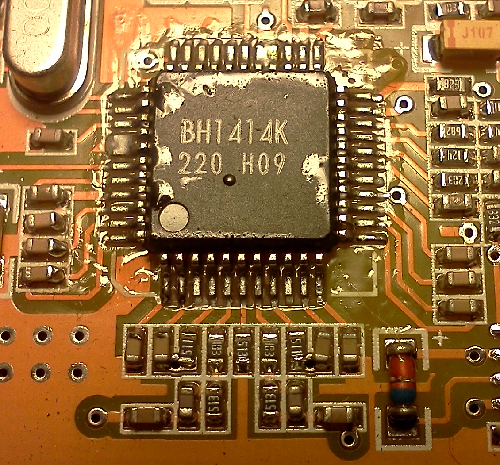MrBruce1959
New Member
Hello all I am new here and hope I am posting this in the right area of this forum board.
I am trying to figure out how to set the pre-emphasis curve on the BH1414K Wireless Audio Link IC to 75 microseconds so the audio is compatible with my FM radio which uses 75 Microsecond De-Emphasis.
There is no schematic available to the public and the capacitors which are SMD types have no markings, therefore I can not tell what their values are. I do know some of the resistors are marked 513 which are 51K Ohms.
I contacted the manufacturer and they mentioned two capacitors had to be changed to 1500pF because by default the pre-emphasis is set to 50us.
Here is a readily available data sheet I found for the BH1414K IC chip https://pira.cz/pdf/bh1414k.pdf
Below is a photo of the chip on my circuit board.
At the bottom left of the photo is the left channel circuit and to the right is the right channel circuit.

Does anyone have any clue as to what has to be changed for the correct 75us pre-emphasis curve?
Sorry for my dumb question, but I am new to this part of the learning curve.
Bruce.
I am trying to figure out how to set the pre-emphasis curve on the BH1414K Wireless Audio Link IC to 75 microseconds so the audio is compatible with my FM radio which uses 75 Microsecond De-Emphasis.
There is no schematic available to the public and the capacitors which are SMD types have no markings, therefore I can not tell what their values are. I do know some of the resistors are marked 513 which are 51K Ohms.
I contacted the manufacturer and they mentioned two capacitors had to be changed to 1500pF because by default the pre-emphasis is set to 50us.
Here is a readily available data sheet I found for the BH1414K IC chip https://pira.cz/pdf/bh1414k.pdf
Below is a photo of the chip on my circuit board.
At the bottom left of the photo is the left channel circuit and to the right is the right channel circuit.
Does anyone have any clue as to what has to be changed for the correct 75us pre-emphasis curve?
Sorry for my dumb question, but I am new to this part of the learning curve.
Bruce.
Attachments
Last edited:

